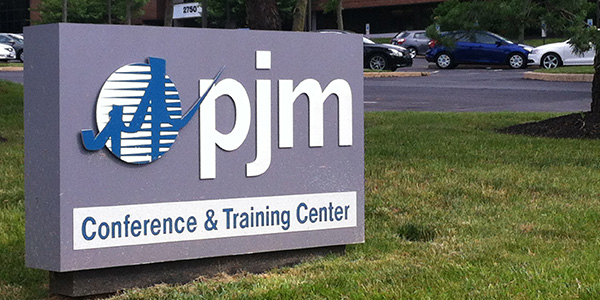PJM stakeholders unanimously endorsed new rules related to public distribution microgrids at last week’s Operating Committee meeting.
Natalie Tacka, an engineer in PJM’s applied innovation department, reviewed the proposed changes to Manual 14D: Generator Operational Requirements. Tacka said work on the issue first began last year in the former Distributed Energy Resources Subcommittee (DERS) and continued into the new DER and Inverter-Based Resources Subcommittee (DIRS).
A microgrid is defined as a system of generating facilities and load that can operate both while connected to and off the main grid, Tacka said. PJM is looking to define a public distribution microgrid as one that contains a PJM generating facility that can generate while connected to and “islanded” from the broader grid and uses public utility distribution wires.
Tacka said a public distribution microgrid would not include any NERC bulk electric or transmission facilities. The electric distribution company would determine if the microgrid is wholesale or retail when islanded.
The Manual 14D changes feature new definitions, including one for a microgrid and a public distribution microgrid, along with provisions for operations in island mode like telemetry and notification requirements and outage reporting.
Tacka said minor updates were made to the manual language after a first read held at last month’s OC meeting.
Stakeholders also unanimously endorsed revisions to Manual 11 and Manual 18 related to the business rules of public distribution microgrids at the Market Implementation Committee meeting Wednesday.
The Manual 11 revisions included provisions for reflecting islanded conditions in resource availability for energy and ancillary services, Tacka said, while the Manual 18 language adds clarification for performance assessment interval treatment of public distribution microgrids serving as capacity resources.
All three manual changes now move on to the Markets and Reliability Committee for a first read at its Dec. 17 meeting and PJM seeking endorsement at the January meeting.
COVID-19 Update
Paul McGlynn of PJM provided an update on the RTO’s operations plan in response to the COVID-19 pandemic, saying it is looking to institute more restrictive measures as the number of cases rises across Pennsylvania and the region.
McGlynn said PJM has decided to push back its return-to-campus plan to May 31. In-person stakeholder meetings will not resume before July, McGlynn said, and will continue to be held virtually.
PJM’s Annual Meeting will also be held virtually in May. McGlynn said the RTO expects to deal with the impacts of the pandemic well into 2021.
“When you hear about it every day, it’s easy to lose track or not appreciate the rate of changes in some of what’s going on,” McGlynn said.
PJM staff have been “doubling down” on social distancing efforts and cleaning protocols in place since they were implemented in March, McGlynn said. Additional cleaning is being conducted in the control rooms, McGlynn said, and changes were made to the air filtration systems.
McGlynn said strict social distancing policies are in place in the control rooms, and staff have been further spread out to limit contact. He said the real-time reliability engineers have been moved off the control room floor and on to the mezzanine level of the Valley Forge, Pa., campus to enhance social distancing.
PJM Senior Engineer Bilge Derin presented an administrative change to Manual 1 Attachment F, a temporary attachment added in April that outlines requirements for non-traditional control room setups during the pandemic. The attachment includes language on communications, redundancy, and cyber and physical security.
The attachment was set to expire on Dec. 31, Derin said, but the change will extend the measures until June 30, 2021.
McGlynn said PJM is also conducting discussions with the Electric Sector Coordinating Council over distributing a COVID-19 vaccine to critical personnel when a vaccine is available.
Greg Poulos, executive director of the Consumer Advocates of the PJM States, asked if any consideration is being given to sequestering control room staff on the campus as it was done in spring at the height of the pandemic.
McGlynnn said there are “active discussions” going on by PJM staff about another possible sequestration. He said dispatchers were originally sequestered for around 10 weeks in the spring.
“I think it’s likely to be driven based on the data and the numbers of infections we are seeing,” McGlynn said.
SRCS Sunset Proposal, SOS Charter Review
Brian Lynn of PJM reviewed a proposal to sunset the System Restoration Coordinators Subcommittee (SRCS), which was originally created in 2012 but has not met since February 2019.
Lynn said the SRCS previously addressed unique responsibilities among PJM subcommittees, including administering, coordinating and debriefing restoration drills conducted within the RTO footprint. It also served as point for system restoration-related issues, made recommendations for changes to Manual 36 and conducted an annual review of each member company’s restoration manual as required by NERC standards for how they will respond to system disturbance conditions or a blackout.
Lynn said PJM staff have acknowledged that the subcommittee’s listed responsibilities are all important, but all of its work are currently supported by other groups. The sunsetting of the SRCS would reduce duplicative work and meetings, he said.
Much of the subcommittee’s work is now conducted at the Dispatcher Training Subcommittee, the System Operations Subcommittee (SOS) and the PJM Transmission Operations Department, Lynn said.
The OC will be asked to endorse the proposal at its Jan. 13 meeting.
Paul Dajewski of PJM also reviewed the proposed charter update for the SOS. The updates involved minor changes as part of the annual review process.
PJM removed a reference to the SRCS because of the sunset proposal. The changes also include referring to “user groups” as “forums” and the addition of the eDART XML Forum as a group established to assist the SOS in carrying out its responsibilities.
The OC will vote on the changes at its next meeting.






